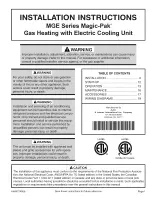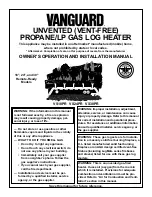
4
SECTION 6: INSTRUCTIONS FOR PRESSURE TEST GAUGE CONNECTION
6.1. Supply Pressure: Installer to provide a 1/8" N.P.T. plugged tapping, accessible for test gauge connection immediately
upstream of the gas supply connection to the heater.
6.2. Manifold Pressure: Turn gas valve to "OFF" position. Remove 1/8" plug from manifold downstream from the valve and
connect 1/8" nipple to the tapped hole. Connect gauge to nipple. Turn on the gas supply.
6.3. With the main burner operating, check burner manifold pressure using a water manometer (see Table 4 on page 4 for
correct setting pressures). If adjustment is required, remove cover screw of the appliance regulator. Using a small
screwdriver, turn adjustment screw clockwise
to increase or counter-clockwise to decrease
gas pressure to
burner. Replace cover screw.
6.4. Gauges which measure in pounds per square inch or ounces per square inch are not accurate enough to measure or
set the manifold pressure. Use a water manometer.
*Minimum permissible gas supply pressure for purpose of input adjustment.
SECTION 7: INFORMATION FOR LP GAS FLOOR MODEL HEATERS ONLY
Heaters used with LP gas must be installed in accordance with the latest edition of the National Fuel Gas Code -NFPA54,
Standard for the Storage and Handling of LP Gas - NFPA 58, all state and local codes or the authority having jurisdiction.
See Section 7.1 “LP models only - Regulator and hose assembly instructions” on page 5 for specific LP connection informa-
tion.
The heater must be connected to the tank or cylinder by a UL Listed hose assembly or hard piping. A 10 foot assembly of UL
Listed hose is available from Sunstar under Part No. 3052200. A single stage LP gas regulator (operation range: 10-150
PSIG inlet and 11.0" W.C. outlet) having a POL fitting with an excess flow valve is included with each hose assembly Part
No. 3052400.
The hose assembly must be visually inspected prior to each use of the heater. If it is evident there is excessive abrasion or
wear, or the hose is cut, it must be replaced prior to the heater being put into operation. The replacement hose must a UL
Listed hose assembly.
The volume of a given quantity of liquid LP gas in a container is directly related to its temperature. As a result, the vaporiza-
tion rate of a tank or cylinder will decrease as the temperature drops and as the percentage of liquid in the container
becomes smaller. Table 5 on page 4 shows the approximate vaporization rate of a 100 lb. cylinder.
** Rate of vaporization drops below the heater input rate.
Table 4: Gas supply pressures
GAS TYPE
MANIFOLD PRESSURE
MINIMUM*
MAXIMUM
Natural
3.5" W.C.
5" W.C.
14" W.C.
Propane
10" W.C.
11" W.C.
14" W.C.
Table 5: Maximum Continuous Flow in BTU/Hr. At Various Temperatures (Degrees
F)
Lbs. of Propane in
Cylinder
20
o
F
40
o
F
60
o
F
70
o
F
100
167,000
214,000
277,000
300,000
80
137,000
180,000
214,000
236,000
60
109,000
140,000
176,000
197,000
40
**
105,000
131,000
141,000
30
**
**
107,000
118,000
Summary of Contents for RCH100
Page 3: ......

































